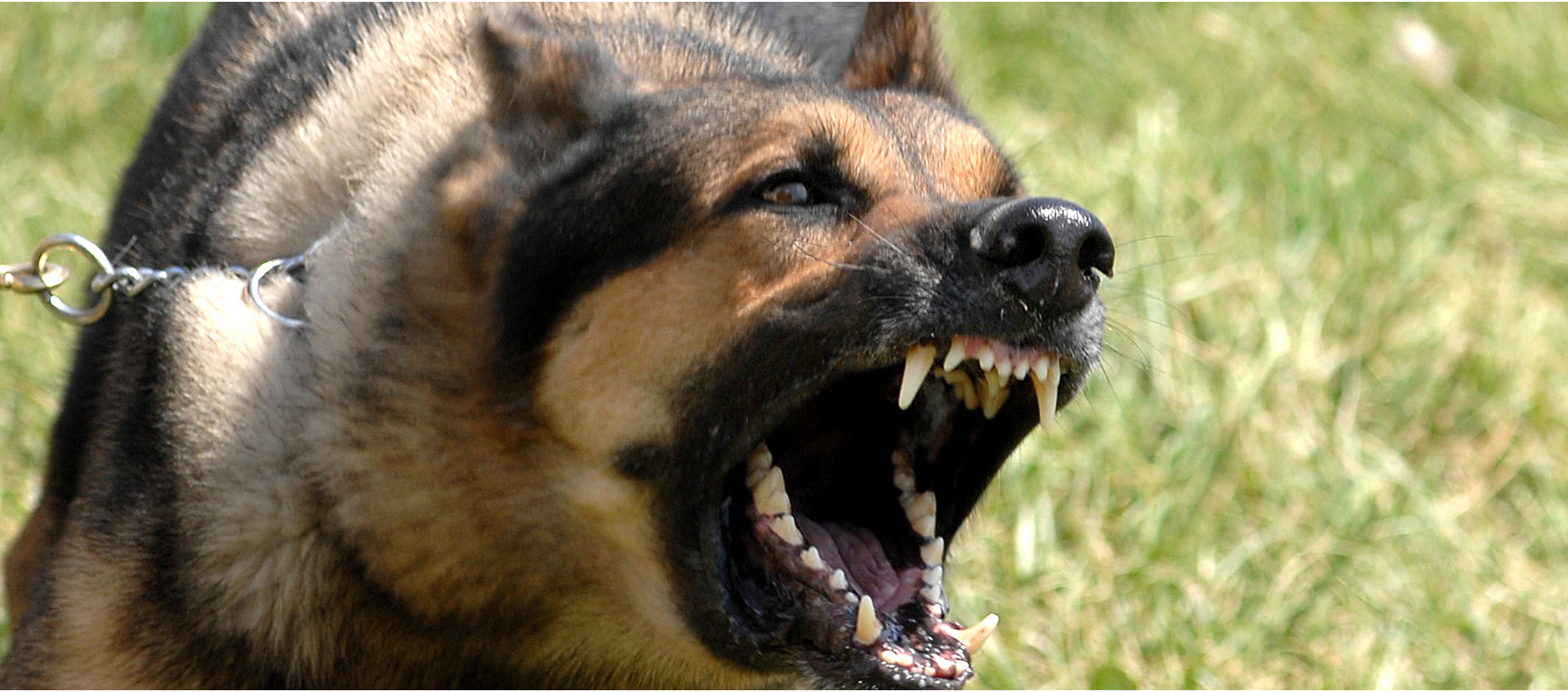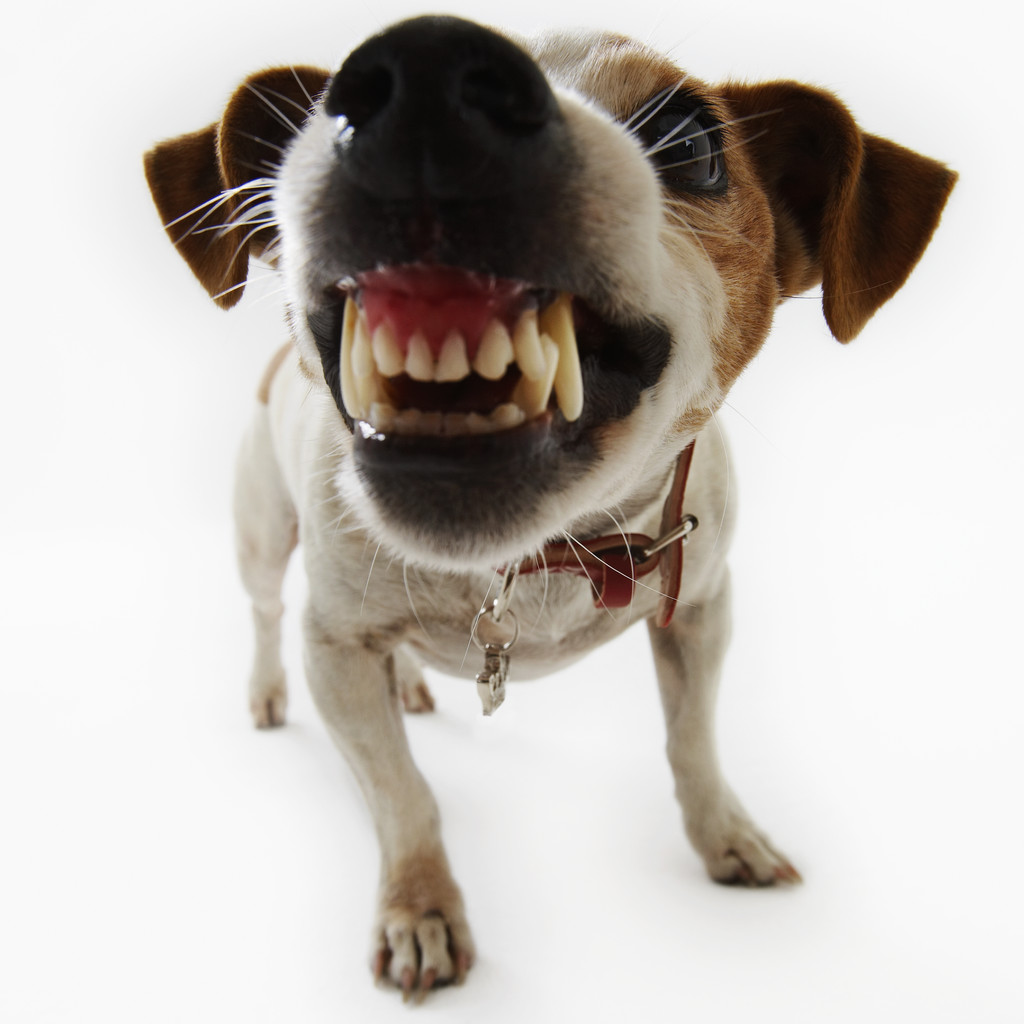
When we think of dogs normally the image of a cute loving best friend comes to mind. Sometimes though our canine counterparts can show a darker side through growling, barking, snarling or in the worst case, biting. This does not indicate that you have a dangerous pet or that you are a mean caretaker. Statistics show that around 40% of dogs have, at some point, shown signs of dog aggression and growled or snapped at their owner.
Dogs do not just have a switch that randomly flips from “nice” to “mean” without reason. There are several levels of dog aggression and some are perfectly normal in certain situations. Typically pets are convinced they have a valid reason to lash out when they do. If your furry friend is suddenly aggressive and displays a notable change in behavior then you should always contact your veterinarian immediately as this could be brought on by internal pain or a health condition. Constant dog aggression can be a tricky thing to cure and might require the talent of a professional trainer.
To help you better identify the scale of aggressive behavior in your dog we have compiled 5 basic types of dog aggression and some simple tips on dealing with each one.
Territorial – This classification of dog aggression usually is experienced by protection or herding based breeds. This is the tried and true scenario in which your dog barks or growls anytime the catch a glimpse of someone coming to the door or through your yard. This reaction is reinforced when the dog succeeds in making the person or other animal leave immediately by showing their aggressive nature.
A good way to combat this is to plan ahead with someone the dog is not familiar with. Let them walk through the yard or up to the door and once your dog begins barking or lunging have them toss him one of his favorite treats. As the dog takes a break to quietly munch on the snack the person should praise them and walk away. This lets your dog know that in order to get the result they are looking for it is better to be calm and not aggressive.
Play - This type of aggression is not really aggression at all. It may look frightening but dogs have a special way of letting each other know that it’s all a game. From an early age dogs learn to hold back on their biting when playing.
If your puppy bites too hard when playing a good conditioning technique is to whine or whimper and let the puppy know verbally that the bite was too hard. After you alert them to this fact, it is also good to give them a short “time out” from play time to quickly show them that play time is over if they bite too strongly.
Fear - When a canine feels trapped or is just downright scared this type of dog aggression begins to emerge. It is a pretty well known fact that a cornered or caged dog will often bite or growl out of fear. In their experience, a loud bark or menacing growl will usually make the thing that has frightened them go away. Dog also tend to be scared of hands reaching towards their heads because to them it looks like a threat.
Try to avoid going directly for the head when petting. Instead try to pet the dog’s back or side. Staring can also be interpreted as a form of intimidation by pets. One of the best things to do to combat fear related aggression is to build a strong bond with your pet that encourages trust and love.
Dominance - This form of dog aggression involves guarding specific items that your pet deems to be his own. This can include certain pieces of furniture, favorite toys, and a freshly filled food bowl. This behavior is typically found in young males that have not been neutered. This dog aggression is also reinforced by the fact that whenever the dog growls whoever is moving in on his stuff generally backs off.
The simplest cure for this type of behavior is to have your dog neutered which will cut down on the dominating attitude. Another, less intrusive method is to take away the items that the dog is possessive about and only use them as a reward when they have behaved properly or obeyed a command. This reinforces positive behavior and shows the pet that negative or aggressive activity does not get them what they want.
Predatory - This type of aggression is deep seeded in a dog’s instincts and originates from the necessity to hunt for food. It can include stalking, running down, and biting. This predator instinct can often be triggered by moving objects or sounds made by young children or smaller animals.
This form of dog aggression tends to disappear the older a dog gets. Keeping a watchful eye on your pet pal may be necessary in order to intervene when they start to go into predator mode. It is important to learn what sets you dog off and makes them give chase, then attempt to avoid these triggers. It is not an easy task to snap them out of this mode of behavior but a good technique is to find a word or phrase that immediately makes them content and interested like” treat”, “go for a ride”, or “ball”. We also offer personalized pet tags to let others know in the case that your pet runs off, that your pet is agressive or has any other behavioral or medical issue.
 | Dealing with dog aggression can be a difficult practice that involves great time and patience on behalf of the owner. If you feel overwhelmed or are concerned about injury to others then you should always consult a professional to lend you a hand or enlist the services of a qualified dog trainer. This will ensure your dog learns to stay calm and under control. |
Russ Barker has been the victim of dog aggression several times but never lets it affect his love for the creatures or his self-confidence. He spends most his days as an efficient manager and pet blogger at DogTagArt.com, a fast-growing enterprise that encourages pet safety through unique and high-quality pet ID tags. Their mission is to ensure that as many pets as possible are returned home because they are wearing proper identification. These stylish custom dog tags are an excellent tool to prevent the loss of your best friends.

